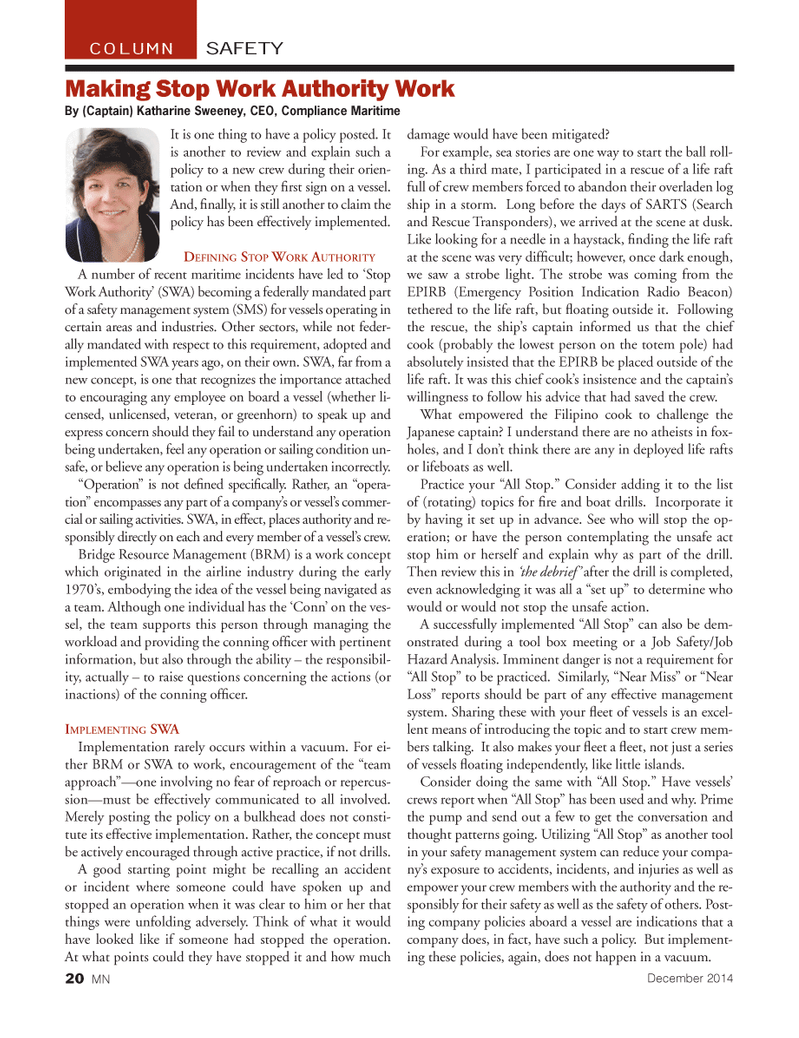
Page 20: of Marine News Magazine (December 2014)
Salvage & Spill Response
Read this page in Pdf, Flash or Html5 edition of December 2014 Marine News Magazine
It is one thing to have a policy posted. It is another to review and explain such a policy to a new crew during their orien- tation or when they Þ rst sign on a vessel. And, Þ nally, it is still another to claim the policy has been effectively implemented. DEFINING STOP WORK AUTHORITY A number of recent maritime incidents have led to ÔStop Work AuthorityÕ (SWA) becoming a federally mandated part of a safety management system (SMS) for vessels operating in certain areas and industries. Other sectors, while not feder- ally mandated with respect to this requirement, adopted and implemented SWA years ago, on their own. SWA, far from a new concept, is one that recognizes the importance attached to encouraging any employee on board a vessel (whether li- censed, unlicensed, veteran, or greenhorn) to speak up and express concern should they fail to understand any operation being undertaken, feel any operation or sailing condition un- safe, or believe any operation is being undertaken incorrectly. ÒOperationÓ is not deÞ ned speciÞ cally. Rather, an Òopera- tionÓ encompasses any part of a companyÕs or vesselÕs commer- cial or sailing activities. SWA, in effect, places authority and re- sponsibly directly on each and every member of a vesselÕs crew. Bridge Resource Management (BRM) is a work concept which originated in the airline industry during the early 1970Õs, embodying the idea of the vessel being navigated as a team. Although one individual has the ÔConnÕ on the ves- sel, the team supports this person through managing the workload and providing the conning ofÞ cer with pertinent information, but also through the ability Ð the responsibil- ity, actually Ð to raise questions concerning the actions (or inactions) of the conning ofÞ cer. IMPLEMENTING SWA Implementation rarely occurs within a vacuum. For ei- ther BRM or SWA to work, encouragement of the Òteam approachÓÑone involving no fear of reproach or repercus- sionÑmust be effectively communicated to all involved. Merely posting the policy on a bulkhead does not consti- tute its effective implementation. Rather, the concept must be actively encouraged through active practice, if not drills. A good starting point might be recalling an accident or incident where someone could have spoken up and stopped an operation when it was clear to him or her that things were unfolding adversely. Think of what it would have looked like if someone had stopped the operation. At what points could they have stopped it and how much damage would have been mitigated? For example, sea stories are one way to start the ball roll- ing. As a third mate, I participated in a rescue of a life raft full of crew members forced to abandon their overladen log ship in a storm. Long before the days of SARTS (Search and Rescue Transponders), we arrived at the scene at dusk. Like looking for a needle in a haystack, Þ nding the life raft at the scene was very difÞ cult; however, once dark enough, we saw a strobe light. The strobe was coming from the EPIRB (Emergency Position Indication Radio Beacon) tethered to the life raft, but ß oating outside it. Following the rescue, the shipÕs captain informed us that the chief cook (probably the lowest person on the totem pole) had absolutely insisted that the EPIRB be placed outside of the life raft. It was this chief cookÕs insistence and the captainÕs willingness to follow his advice that had saved the crew. What empowered the Filipino cook to challenge the Japanese captain? I understand there are no atheists in fox- holes, and I donÕt think there are any in deployed life rafts or lifeboats as well. Practice your ÒAll Stop.Ó Consider adding it to the list of (rotating) topics for Þ re and boat drills. Incorporate it by having it set up in advance. See who will stop the op- eration; or have the person contemplating the unsafe act stop him or herself and explain why as part of the drill. Then review this in ?the debrief? after the drill is completed, even acknowledging it was all a Òset upÓ to determine who would or would not stop the unsafe action. A successfully implemented ÒAll StopÓ can also be dem- onstrated during a tool box meeting or a Job Safety/Job Hazard Analysis. Imminent danger is not a requirement for ÒAll StopÓ to be practiced. Similarly, ÒNear MissÓ or ÒNear LossÓ reports should be part of any effective management system. Sharing these with your ß eet of vessels is an excel- lent means of introducing the topic and to start crew mem- bers talking. It also makes your ß eet a ß eet, not just a series of vessels ß oating independently, like little islands. Consider doing the same with ÒAll Stop.Ó Have vesselsÕ crews report when ÒAll StopÓ has been used and why. Prime the pump and send out a few to get the conversation and thought patterns going. Utilizing ÒAll StopÓ as another tool in your safety management system can reduce your compa- nyÕs exposure to accidents, incidents, and injuries as well as empower your crew members with the authority and the re- sponsibly for their safety as well as the safety of others. Post- ing company policies aboard a vessel are indications that a company does, in fact, have such a policy. But implement- ing these policies, again, does not happen in a vacuum. SAFETYCOLUMNMaking Stop Work Authority Work By (Captain) Katharine Sweeney, CEO, Compliance Maritime December 201420 MNMN Dec14 Layout 18-31.indd 20MN Dec14 Layout 18-31.indd 2011/25/2014 10:13:38 AM11/25/2014 10:13:38 AM

 19
19

 21
21
